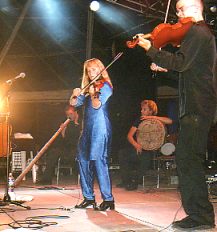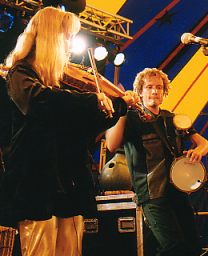FolkWorld article by Eelco
Schilder:
Calling the ancient goddess Sjofnx
The Finnish-Swedish band Gjallarhorn
 At
the end of 2000 Gjallarhorn released their second cd called Sjofn. Their first
cd Ranarop had been released a few years before on an international label but
owing to the inadequate distribution and bad commercial management of the record
company this cd never reached many listeners. How different that is with Sjofn.
Not only did it surprise many reviewers of folk magazines; it also found its
way into several rock magazines as being original and stunning psycho music.
Lead singer Jenny Wilhelmsen is the driving force behind the group and almost
addicted to finding new material. New material? No, ... old material. Songs
that have a long tradition, tunes that cannot be found in a written form but
still exist on old tapes or in people's hearts.
At
the end of 2000 Gjallarhorn released their second cd called Sjofn. Their first
cd Ranarop had been released a few years before on an international label but
owing to the inadequate distribution and bad commercial management of the record
company this cd never reached many listeners. How different that is with Sjofn.
Not only did it surprise many reviewers of folk magazines; it also found its
way into several rock magazines as being original and stunning psycho music.
Lead singer Jenny Wilhelmsen is the driving force behind the group and almost
addicted to finding new material. New material? No, ... old material. Songs
that have a long tradition, tunes that cannot be found in a written form but
still exist on old tapes or in people's hearts.
Although their music sounds very modern, Jenny denies that they play modern
folk music. Jenny: "I do not want people to call our music modern folk music.
We want to stay as close to tradition as possible. I think that the music has
enough to offer and does not need electronic instruments to make it fit in with
our modern times."
Although they stay close to tradition, the instruments they use are not all
traditional Scandinavian ones. The didgeridoo plays an important part in Gjallarhorn's
music. Jenny: "To be honest, I was terribly prejudiced against the didgeridoo.
I know a few groups who only use this instrument because of its special sound
and not because it adds something to their music. But in much of the old material
they originally used a drone. Violins played in a special way were largely responsible
for this basic, almost hypnotizing tone. One night we were playing old traditional
songs on the violin when our didgeridoo player joined in and we discovered that
this was a great combination. The didgeridoo had the same hypnotizing drone
and sounded great with the violins. Many people have criticized the fact that
we make use of percussion instruments. These people forget that percussion was
frequently used in traditional music. We do not always use the same percussion
instruments but they certainly contribute to our special sound. Instead of violins
we use the didgeridoo and instead of the old shaman drum we use percussion instruments
from other parts of the world."
 Most
material that can be heard on Sjofn dates back to the Middle Ages, but the Runo
tradition is also an important source of inspiration. Jenny: "Runo is a very
old vocal tradition that is approximately 2000 years old and was mainly used
in Finland and the Baltic states. For many people it was like a second language
and they used it until about 100 years ago. Runo was used to "broadcast" certain
messages and it has many similarities to Nordic mythology. It has the same structure
and there is a lot of symbolism in the texts. For me, the Runo tradition is
so fascinating because it is still very close to the original. That is also
why I am studying in Norway at the moment; it is a very special country with
many old traditions. Some valleys have been cut off from the rest of the world
for ages and you still find well-preserved vocal traditions there. Telemarken
is one of the most famous examples of such valleys."
Most
material that can be heard on Sjofn dates back to the Middle Ages, but the Runo
tradition is also an important source of inspiration. Jenny: "Runo is a very
old vocal tradition that is approximately 2000 years old and was mainly used
in Finland and the Baltic states. For many people it was like a second language
and they used it until about 100 years ago. Runo was used to "broadcast" certain
messages and it has many similarities to Nordic mythology. It has the same structure
and there is a lot of symbolism in the texts. For me, the Runo tradition is
so fascinating because it is still very close to the original. That is also
why I am studying in Norway at the moment; it is a very special country with
many old traditions. Some valleys have been cut off from the rest of the world
for ages and you still find well-preserved vocal traditions there. Telemarken
is one of the most famous examples of such valleys."
The process of making a new cd takes a lot of time but Jenny puts her heart
and soul into it. Jenny: "We are not the kind of group that want to release
a cd each year and I cannot tell you what our next cd will sound like either.
As I told you before, I will be studying in Norway for a year and that country
is fantastic, so I'm sure we will use some Norwegian music on our next album.
It's so fascinating to listen to old recordings and meet people who are still
part of that ancient tradition."
Discography: 1997 Ranarop; 2000 Sjofn
Please visit www.gjallarhorn.com for
more info, music and videoclips.
Photo Credit: Gjallarhorn at Tatihou festival anf Folkwoods
festival 2001, photos by The Mollis
Back to the content of FolkWorld Articles, Live Reviews & Columns
To the content of FolkWorld
online magazine Nr. 20
© The Mollis - Editors
of FolkWorld; Published 12/2001
All material published in FolkWorld is © The Author via FolkWorld. Storage for private use is allowed and welcome. Reviews and extracts of up to 200 words may be freely quoted and reproduced, if source and author are acknowledged. For any other reproduction please ask the Editors for permission.
FolkWorld - Home of European Music

Layout & Idea of FolkWorld © The Mollis - Editors of FolkWorld
 At
the end of 2000 Gjallarhorn released their second cd called Sjofn. Their first
cd Ranarop had been released a few years before on an international label but
owing to the inadequate distribution and bad commercial management of the record
company this cd never reached many listeners. How different that is with Sjofn.
Not only did it surprise many reviewers of folk magazines; it also found its
way into several rock magazines as being original and stunning psycho music.
Lead singer Jenny Wilhelmsen is the driving force behind the group and almost
addicted to finding new material. New material? No, ... old material. Songs
that have a long tradition, tunes that cannot be found in a written form but
still exist on old tapes or in people's hearts.
At
the end of 2000 Gjallarhorn released their second cd called Sjofn. Their first
cd Ranarop had been released a few years before on an international label but
owing to the inadequate distribution and bad commercial management of the record
company this cd never reached many listeners. How different that is with Sjofn.
Not only did it surprise many reviewers of folk magazines; it also found its
way into several rock magazines as being original and stunning psycho music.
Lead singer Jenny Wilhelmsen is the driving force behind the group and almost
addicted to finding new material. New material? No, ... old material. Songs
that have a long tradition, tunes that cannot be found in a written form but
still exist on old tapes or in people's hearts.  Most
material that can be heard on Sjofn dates back to the Middle Ages, but the Runo
tradition is also an important source of inspiration. Jenny: "Runo is a very
old vocal tradition that is approximately 2000 years old and was mainly used
in Finland and the Baltic states. For many people it was like a second language
and they used it until about 100 years ago. Runo was used to "broadcast" certain
messages and it has many similarities to Nordic mythology. It has the same structure
and there is a lot of symbolism in the texts. For me, the Runo tradition is
so fascinating because it is still very close to the original. That is also
why I am studying in Norway at the moment; it is a very special country with
many old traditions. Some valleys have been cut off from the rest of the world
for ages and you still find well-preserved vocal traditions there. Telemarken
is one of the most famous examples of such valleys."
Most
material that can be heard on Sjofn dates back to the Middle Ages, but the Runo
tradition is also an important source of inspiration. Jenny: "Runo is a very
old vocal tradition that is approximately 2000 years old and was mainly used
in Finland and the Baltic states. For many people it was like a second language
and they used it until about 100 years ago. Runo was used to "broadcast" certain
messages and it has many similarities to Nordic mythology. It has the same structure
and there is a lot of symbolism in the texts. For me, the Runo tradition is
so fascinating because it is still very close to the original. That is also
why I am studying in Norway at the moment; it is a very special country with
many old traditions. Some valleys have been cut off from the rest of the world
for ages and you still find well-preserved vocal traditions there. Telemarken
is one of the most famous examples of such valleys."